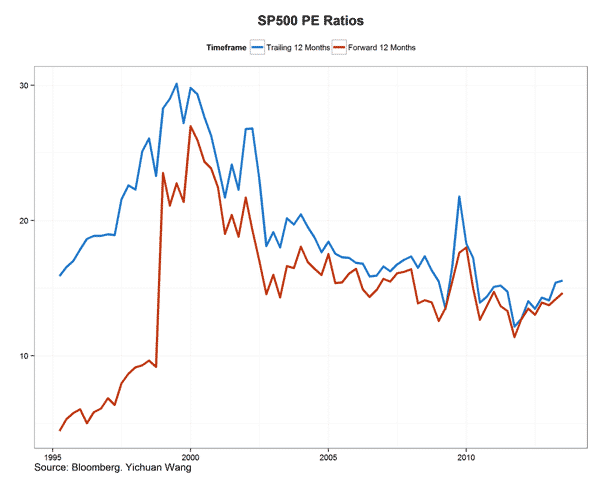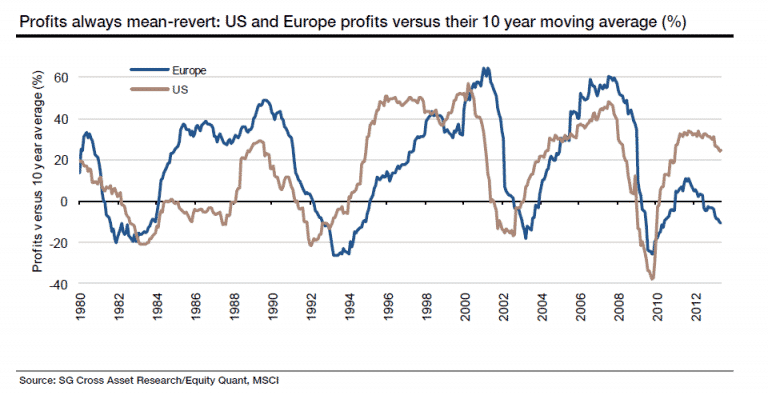On market vulnerability, profits, p/e ratios and the S&P500
Today’s commentary
Summary: My caution on U.S. markets is based not just on technical factors coming from the crisis in emerging markets and the longstanging lack of a market correction. I am also concerned that interest rates have started to rise against a backdrop of weaker profit margins.
I have heard a lot of commentary of late about the potential for a ‘crash’ or a large market correction. It seems people are nervous given how volatile the emerging markets have been recently. I am also concerned about this and the spillover effect the crisis there could have. But there are more fundamental reasons to be concerned about a market correction.
Yesterday, I posted a link to a post called “Popping the “Bubble” Bubble“on Noahpinion, which tried to justify the rise in share prices as driven by fundamentals induced by Qe’s support of the real economy. I thought the analysis was interesting in how it delineated the potential benefits from QE:
On first approximation, the value of a stock should be equal to the present discounted value of all dividend payments. Sure, there’s excess volatility around the edges, but this simple model of cash flows is still accurate on average. In doing so, it gives us two ceteris paribus predictions about stock prices. First, a stock price should go up in response to higher expected future cash flows. Second, a stock price should go down with higher expected real interest rates, because a higher real rate reduces the discounted value of future cash flows. These are the two main channels through which monetary policy impacts stock prices. Monetary policy can either (1) raise the cash flows by improving the economic environment, or (2) lower the discount rate by maintaining an extended period of low real rates.
These two channels split quite nicely into a positive and negative take on the effect of monetary policy. If monetary policy raises stock prices because of current and future cash flows, that should be seen as a good sign of a recovering economic environment. This corresponds to “the Fed is improving the fundamentals of the economy.” On the other hand, if monetary policy affects stock prices only through a lower discount rate, that is just a sign of an “immaculate conception“, with stock prices rising without an improving economy.
The post then went into a discussion of how and why P/E ratios show that it is fundamentals that are improving. I wrote yesterday that it’s not the absolute P/E level that matters, but where the P/E is moving – up or down. The author of the article even says the exact same thing at the beginning of the piece but then does an analysis that completely ignores this. And of course, P/E ratios are moving up, which says discount rates are a big factor in why the market continues to stay elevated.
Let me add a little colour here. This is where the author says it is the change in P/E/ that matters:
“If the fundamental story is correct, then we should observe that the price to earnings ratio stays relatively constant. Yes, stock prices are rising, but that’s only because earnings are stronger. If the speculative excess story is correct, then the price to earnings ratio should be rapidly rising as the price is bid up, but the underlying earnings remain unchanged.”
Even according to the post’s graphs, P/E ratios ARE moving up.

Elsewhere the increase in P/E ratios is also corroborated. See here for example:
And I would posit that one then has to ask the question whether we are looking at GAAP earnings or S&P operating earnings because the two are once again diverging, suggesting that the S&P earnings are not stripping out losses that are material. If we look at earnings from the national income and product accounts, then earnings have actually declined and most all of the gain is discount ratios.
https://blog.bea.gov/tag/corporate-profits/
So that’s my thought process there. Here’s another piece by Mebane Faber on a controversial defender of share price rises, Jeremy Siegel, the Wharton business school professor. Let me quote here in full because I think this is crucial:
Jeremy Siegel talks about CAPE in a recent FT article. He has a few criticisms, but misses the bigger picture in my opinion.
1. He talks about write downs and how that biases CAPE. The problem is, even if you ignored the bear market, even if the earnings decline of 2008,2009, 2010 never happened, effect on PE10 / CAPE would be mild- it would go from 23.7 to 21.2. In other words it is still expensive! (This was a month ago).
Today SocGen put out an excellent piece titled “To Ignore CAPE is to Deny Mean Reversion”
They use the MSCI earnings index that doesn’t include the writedowns and they come to the same conclusions as using the S&P series.
2. CAPE isn’t really a short term timing measure for one market. Like most valuation measures, it’s not that helpful telling you what to do for the next 6 months. It makes much more sense to align the indicator with your holdings period. Here is a post we did – Broadening the Window. However, pretty much every value measure we track aligns to say the same thing – US stocks are expensive.
3. But the biggest point that he misses, is that in a global world why focus on just the US? There are well over 40 investable countries in the world, why just settle for one? We have shown numerous times that selecting countries on a relative basis on CAPE works great to not only pick winners, but also to avoid the bubbly losers. And according to CAPE, the US is the second most expensive market we track right now…and according to 1 year PE, it is the 4th most expensive…and according to P/B…etc
If you do a composite across 10PE, 1PE, FCF, P/B, and dividends…the US is still the 4th most expensive…
4. Note the potential for margin mean reversion in the below chart from the SocGen piece….which side would you rather bet on?
Conclusion from Lapthorne at SocGen:
“At the peak of the cycle, when profits are far above average and the economy is doing well, it is hard to imagine earnings collapsing back below the average, as it is to imagine a depressed region recovering. Mean-reversion in earnings, though sometimes delayed, is as undeniable as the economic cycle itself. Cyclically adjusted (or trend) PE calculations will always give a conservative valuation estimate. But that is exactly the point of valuation – to offer a degree of safety (a margin of error) and to smooth the dangers of the economic cycle. That peak profits typically accompany peak valuations only reinforces the point.
One can always discuss the idiosyncrasies of any particular valuation metric, although we reach similar conclusions to Robert Shiller’s CAPE analysis – but using a more modern time frame and a different (and more generous) earnings series. Our conclusions are that the US equity market is currently expensive. We can also reach a similar conclusion using alternative valuation metrics such as dividend yield, trend PE, and Tobin’s Q.
Most significantly, the downside risk of investing when earnings and valuations are far above historical averages should not be underestimated. from our work, peak earnings go hand-in hand with peak valuations. When earnings revert back to mean (and below), the valuation will also collapse. That many continue to argue against this, and so soon after the collapse of 2008/09, is something we find quite remarkable. “
Where are we in the cycle? We are almost a full six years after the trough began in late 2007. Why should we believe that profit margins are going to go to new highs? We shouldn’t. If not, then we should have to think that profits are going to rise sustainably from here due to a long business cycle underpinned by rising a top line from increased consumer spending that emanates either from wage increases or household debt accumulation. This presupposes that we even have a further increase in profits, which at present we don’t. If it is wages that begin to underpin the cyclical advance in profits, then that is sustainable from a secular perspective. But if it is debt accumulation, then it is not.
So I believe the following:
- This business cycle – at six years from the trough – is long in the tooth and probably 2nd derivatives are headed down, meaning that profit growth and GDP growth are headed downward.
- Profit margins always mean revert and they have already started mean reverting in this cycle.
- Wage growth is punk and by some designations wages and household income are down.
- Interest rates have risen in a disconcerting way, making discount rates higher.
- We are going to see major volatility from emerging markets as this crisis plays out over a longer time frame.
In the face of these constraints, I believe that the market is overdue for a correction and is therefore particularly vulnerable right now. Could the business cycle last another two years?Sure, and even after a correction that could propel stocks forward until secular forces intervene in the next recession. But for the time being, the market does not look cheap to me, it looks expensive and vulnerable.

Comments are closed.